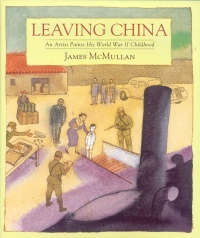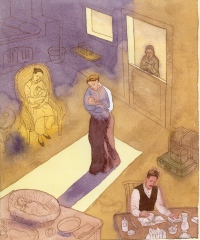| ________________
CM . . .
. Volume XX Number 34. . . .May 2, 2014
excerpt:
James McMullan’s grandparents were Irish- and English-born Christian missionaries in Cheefoo (Yantai) in northeastern China. His father, James Jr., became an entrepreneur and secular businessman although the family business ventures included an import and export business that helped to support the orphanage, dispensary and other religious work of his family. His mother, Rose, a divorcée with two children, was a charming and witty woman who had been raised on a ranch in Fort Steele in the interior of BC. The couple met when his father was studying music in Vancouver and working part-time as a salesman. These details are all set out to explain how it came to be that James McMullan was born in China in 1934.
By the summer of 1941, the situation had deteriorated so much that British nationals were warned to leave China immediately. Pretending to be merely escorting his wife and son James, the author, to Shanghai, father McMullan secured a cabin for his wife and son on one of the last boats allowed to leave Shanghai, and then he joined the British army. Following a brief stay in Seattle with relatives, James and his mother ended up in Grand Forks, BC, living with his maternal grandparents. As an outsider, James became a ready target for bullying by students and teacher alike for his way of speaking English, and his fine manners were not appreciated. Fortunately, a better experience awaited them on Salt Spring Island in the Strait of Georgia where Rose’s sister and her husband had built a spacious retirement home and his younger cousin offered friendship and coaching in the ways of boyish play. This taste of normalcy was soon disrupted when his mother enrolled him in a boarding school in Vancouver where his inept athletic skills set him apart from his classmates. At the end of the school year in 1944, James and his mother received a cable that they were to travel by train to New York, sail to Bombay, India, and travel overland to Darjeeling where James was to be enrolled in a boarding school and his mother was to continue to Chungking, China, and a reunion with his father who was now a Lieutenant Colonel with the intelligence unit. Pranks and bonding with other students left strong memories for the author whose growing skill at copying comic book figures helped him to establish a standing among his classmates. The death of his father in an aircraft accident in the fall of 1945 led to his first flights, across the Himalayas to Chungking, and then with his mother to Shanghai. Shanghai was then a city of barely controlled chaos as the Nationalist army was losing to the Chinese communist forces. Before long, James and his mother were once more aboard a ship heading to North America and Salt Spring Island. In 11 years, James McMullan lived in four countries and had travelled more of the world than most youngsters could have imagined. Despite being sheltered by his parents, he was living through war and separated from a stable home and lasting friendships in a unique way. The impact of war on his parents is a secondary theme. His budding interest and success in fine art is a third theme. A final entry concisely recounts the rest of McMullan’s story highlighting his artistic career, marriage and parenting and even some late-blooming athleticism as a tennis player. McMullan is a talented illustrator and designer. His memoir is lovingly recounted in 54 single-page episodes, each one set opposite a full-page pen-and-ink watercolour that almost always is closely faithful to the text. The art work is atmospheric with the unifying palette of sepia and purple, augmented at times with darker brown, dark blue and green. The endpapers consist of a tri-panel watercolour map showing his travel route from China across the Pacific to points in North America, across the continent to New York where other oceans carried him to India and on to Chungking. The publisher’s website includes some excellent resources for educators. There is a Q&A with McMullan, Author Insights, an Educator Guide, and a Reader’s Guide, the latter two both written by JoAnn Jonas, a teacher/educator/librarian. The Reader’s Guide contains 17 questions that explore the text, the illustrations, and McMullan’s thoughts and feelings. The extensive Educator Guide includes questions and activities for grades six through ten and is broken into three units: 1. Memoirs/Visual Story Telling/Literary Genres, 2. Social Studies/World War II/Primary Source Materials, 3. Finding Yourself/Societal Gender Roles. Together, these additional resources are invaluable for teachers. Check out the site yourself and see why this book has so much potential: http://www.algonquinyoungreaders.com/book/leaving-china/ Highly Recommended. Val Ken Lem is the liaison librarian for history, English and Caribbean studies at Ryerson University in Toronto, ON.
To comment
on this title or this review, send mail to cm@umanitoba.ca.
Copyright © the Manitoba Library Association. Reproduction for personal
use is permitted only if this copyright notice is maintained. Any
other reproduction is prohibited without permission.
NEXT REVIEW |
TABLE OF CONTENTS FOR THIS ISSUE
- May 2, 2014.
AUTHORS |
TITLES |
MEDIA REVIEWS |
PROFILES |
BACK ISSUES |
SEARCH |
CMARCHIVE |
HOME |

 The memoir focuses in text and illustration on the first eleven years of James McMullan’s life. These formative years spanned a turbulent period that saw his relatively luxurious life as a colonial child growing up in colonial enclave of privilege with servants and parents actively engaged in a lively social scene of the British and American residents gradually become increasingly constrained following the Japanese occupation of China in 1937.
The memoir focuses in text and illustration on the first eleven years of James McMullan’s life. These formative years spanned a turbulent period that saw his relatively luxurious life as a colonial child growing up in colonial enclave of privilege with servants and parents actively engaged in a lively social scene of the British and American residents gradually become increasingly constrained following the Japanese occupation of China in 1937.